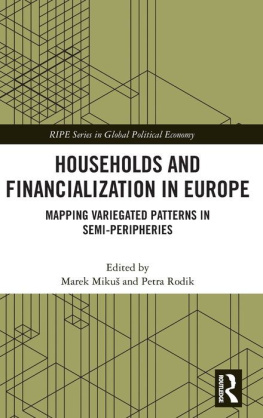Marek Mikus - Households and Financialization in Europe: Mapping Variegated Patterns in Semi-Peripheries
Here you can read online Marek Mikus - Households and Financialization in Europe: Mapping Variegated Patterns in Semi-Peripheries full text of the book (entire story) in english for free. Download pdf and epub, get meaning, cover and reviews about this ebook. year: 2021, publisher: Routledge, genre: Politics. Description of the work, (preface) as well as reviews are available. Best literature library LitArk.com created for fans of good reading and offers a wide selection of genres:
Romance novel
Science fiction
Adventure
Detective
Science
History
Home and family
Prose
Art
Politics
Computer
Non-fiction
Religion
Business
Children
Humor
Choose a favorite category and find really read worthwhile books. Enjoy immersion in the world of imagination, feel the emotions of the characters or learn something new for yourself, make an fascinating discovery.
- Book:Households and Financialization in Europe: Mapping Variegated Patterns in Semi-Peripheries
- Author:
- Publisher:Routledge
- Genre:
- Year:2021
- Rating:5 / 5
- Favourites:Add to favourites
- Your mark:
- 100
- 1
- 2
- 3
- 4
- 5
Households and Financialization in Europe: Mapping Variegated Patterns in Semi-Peripheries: summary, description and annotation
We offer to read an annotation, description, summary or preface (depends on what the author of the book "Households and Financialization in Europe: Mapping Variegated Patterns in Semi-Peripheries" wrote himself). If you haven't found the necessary information about the book — write in the comments, we will try to find it.
Marek Mikus: author's other books
Who wrote Households and Financialization in Europe: Mapping Variegated Patterns in Semi-Peripheries? Find out the surname, the name of the author of the book and a list of all author's works by series.
Households and Financialization in Europe: Mapping Variegated Patterns in Semi-Peripheries — read online for free the complete book (whole text) full work
Below is the text of the book, divided by pages. System saving the place of the last page read, allows you to conveniently read the book "Households and Financialization in Europe: Mapping Variegated Patterns in Semi-Peripheries" online for free, without having to search again every time where you left off. Put a bookmark, and you can go to the page where you finished reading at any time.
Font size:
Interval:
Bookmark:
- Field-defining theoretical advances in International Political Economy
- Novel treatments of key issue areas, both historical and contemporary, such as global finance, trade, and production
- Analyses that explore the political economic dimensions of relatively neglected topics, such as the environment, gender relations, and migration
- Accessible work that will inspire advanced undergraduates and graduate students in International Political Economy.
Governing Surplus and Survival in Global Capitalism
Susanne Soederberg
Mapping Variegated Patterns in Semi-Peripheries
Edited by Marek Miku and Petra Rodik
Font size:
Interval:
Bookmark:
Similar books «Households and Financialization in Europe: Mapping Variegated Patterns in Semi-Peripheries»
Look at similar books to Households and Financialization in Europe: Mapping Variegated Patterns in Semi-Peripheries. We have selected literature similar in name and meaning in the hope of providing readers with more options to find new, interesting, not yet read works.
Discussion, reviews of the book Households and Financialization in Europe: Mapping Variegated Patterns in Semi-Peripheries and just readers' own opinions. Leave your comments, write what you think about the work, its meaning or the main characters. Specify what exactly you liked and what you didn't like, and why you think so.









